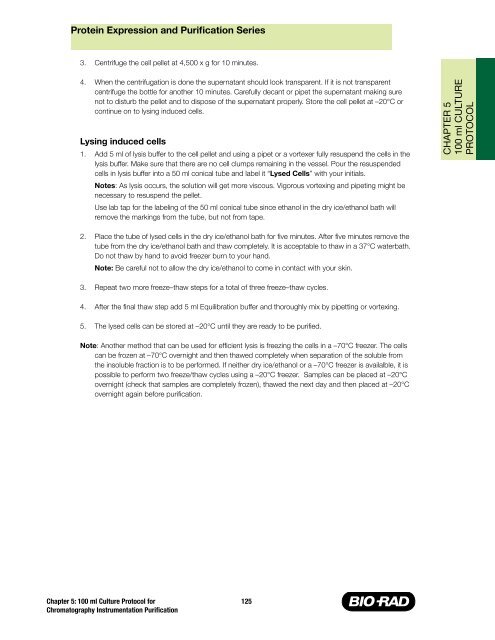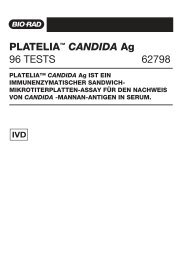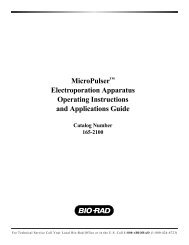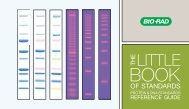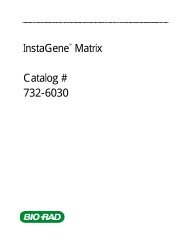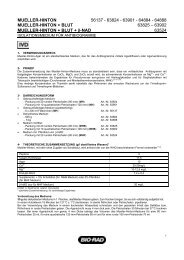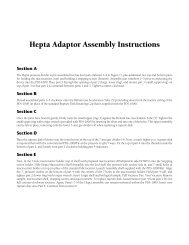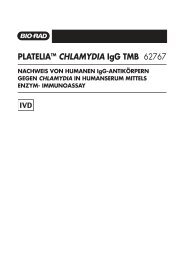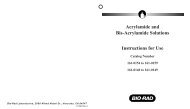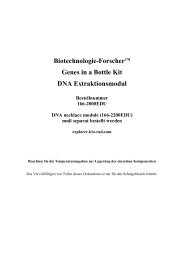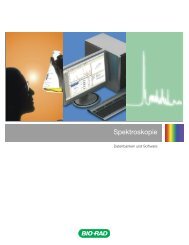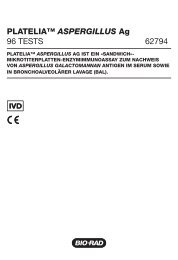Protein Expression and Purification Series - Bio-Rad
Protein Expression and Purification Series - Bio-Rad
Protein Expression and Purification Series - Bio-Rad
You also want an ePaper? Increase the reach of your titles
YUMPU automatically turns print PDFs into web optimized ePapers that Google loves.
<strong>Protein</strong> <strong>Expression</strong> <strong>and</strong> <strong>Purification</strong> <strong>Series</strong><br />
3.<br />
4.<br />
Centrifuge the cell pellet at 4,500 x g for 10 minutes.<br />
When the centrifugation is done the supernatant should look transparent. If it is not transparent<br />
centrifuge the bottle for another 10 minutes. Carefully decant or pipet the supernatant making sure<br />
not to disturb the pellet <strong>and</strong> to dispose of the supernatant properly. Store the cell pellet at –20°C or<br />
continue on to lysing induced cells.<br />
Lysing induced cells<br />
1. Add 5 ml of lysis buffer to the cell pellet <strong>and</strong> using a pipet or a vortexer fully resuspend the cells in the<br />
lysis buffer. Make sure that there are no cell clumps remaining in the vessel. Pour the resuspended<br />
cells in lysis buffer into a 50 ml conical tube <strong>and</strong> label it “Lysed Cells” with your initials.<br />
Notes: As lysis occurs, the solution will get more viscous. Vigorous vortexing <strong>and</strong> pipeting might be<br />
necessary to resuspend the pellet.<br />
Use lab tap for the labeling of the 50 ml conical tube since ethanol in the dry ice/ethanol bath will<br />
remove the markings from the tube, but not from tape.<br />
2.<br />
3.<br />
4.<br />
Place the tube of lysed cells in the dry ice/ethanol bath for five minutes. After five minutes remove the<br />
tube from the dry ice/ethanol bath <strong>and</strong> thaw completely. It is acceptable to thaw in a 37°C waterbath.<br />
Do not thaw by h<strong>and</strong> to avoid freezer burn to your h<strong>and</strong>.<br />
Note: Be careful not to allow the dry ice/ethanol to come in contact with your skin.<br />
Repeat two more freeze–thaw steps for a total of three freeze–thaw cycles.<br />
After the final thaw step add 5 ml Equilibration buffer <strong>and</strong> thoroughly mix by pipetting or vortexing.<br />
5. The lysed cells can be stored at –20°C until they are ready to be purified.<br />
Note: Another method that can be used for efficient lysis is freezing the cells in a –70°C freezer. The cells<br />
can be frozen at –70°C overnight <strong>and</strong> then thawed completely when separation of the soluble from<br />
the insoluble fraction is to be performed. If neither dry ice/ethanol or a –70°C freezer is availalble, it is<br />
possible to perform two freeze/thaw cycles using a –20°C freezer. Samples can be placed at –20°C<br />
overnight (check that samples are completely frozen), thawed the next day <strong>and</strong> then placed at –20°C<br />
overnight again before purification.<br />
Chapter 5: 100 ml Culture Protocol for<br />
Chromatography Instrumentation <strong>Purification</strong><br />
125<br />
CHAPTER 5<br />
100 ml CULTURE<br />
PROTOCOL


